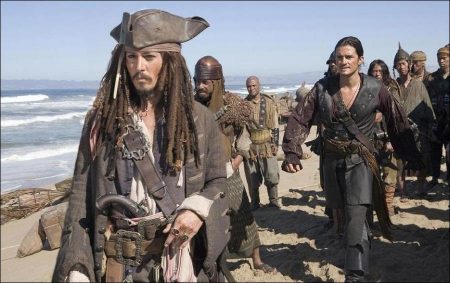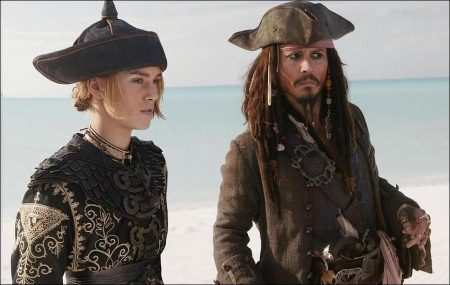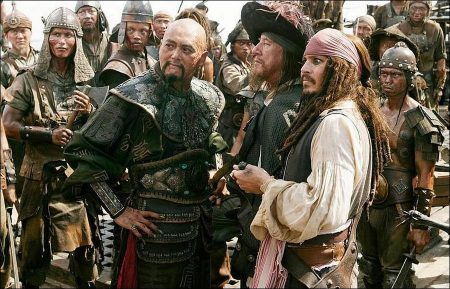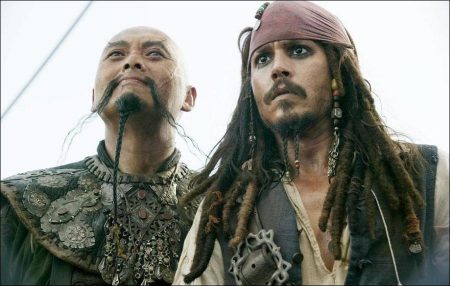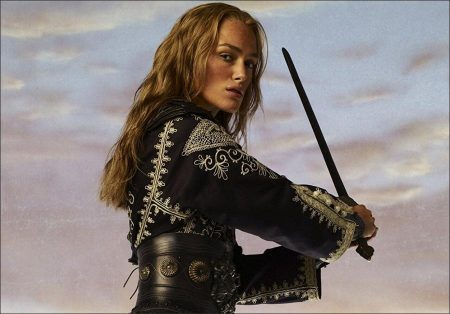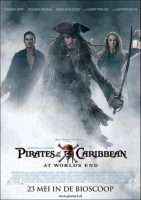Tagline: At the end of the world, the adventure begins.
It is a dark time as the Age of Piracy nears to a close. Lord Cutler Beckett (Tom Hollander) of the East India Company has gained control of the terrifying ghost ship, the Flying Dutchman, and its malevolent, vengeful Captain, Davy Jones (Bill Nighy). The Dutchman now roams the seven seas, unstoppable, destroying pirate ships without mercy, under the command of Admiral Norrington (Jack Davenport).
Will Turner (Orlando Bloom), Elizabeth Swann (Keira Knightley) and Captain Barbossa (Geoffrey Rush) embark on a desperate quest to gather the Nine Lords of the Brethren Court, their only hope to defeat Beckett, the Flying Dutchman, and his Armada.
Johnny Depp, Orlando Bloom, Keira Knightley and Geoffrey Rush reunite in Walt Disney Pictures’ / Jerry Bruckheimer Films’ “Pirates of the Caribbean: At World’s End,” an all new epic tale in the blockbuster series chronicling the fantastical adventures of Captain Jack Sparrow, Captain Barbossa, Will Turner and Elizabeth Swann. This time around, the quartet is joined by international superstar Chow Yun-Fat as Captain Sao Feng, the pirate lord of Singapore.
Produced by Jerry Bruckheimer and directed by Gore Verbinski, Captain Jack and the others set sail on the spectacular new adventure, once again laced with lashing of rollicking and irreverent humor, which takes them into new realms of adventure and fantasy. Two previous “Pirates” adventures smashed records around the world, with “The Curse of the Black Pearl” garnering more than $650 million worldwide, a figure doubled by “Dead Man’s Chest,” which became the third highest-grossing movie in international box office history with more than $1-billion, and a gigantic domestic take of $423,315,812, the sixth highest position in history.
About the Production
Success can be a tough taskmaster…and coming off of “Pirates of the Caribbean: Dead Man’s Chest,” which garnered more than $1 billion internationally and took third position for the top grossing films of all time, Jerry Bruckheimer and Gore Verbinski were absolutely determined to once again rise to, and then go beyond, audience expectations. “It’s scary when you make a picture that’s such a huge success,” confesses Bruckheimer. “You never quite know. It was against conventional wisdom that a pirate movie based on a theme park ride could be such a hit. Then we came back with the second film, and it’s common knowledge in our business that a sequel will make 20 to 30 percent less than the first one. And yet, `Dead Man’s Chest’ made almost double of what `The Curse of the Black Pearl’ took in.”
Bruckheimer attributes the massive success of the first two “Pirates of the Caribbean” films to the enormous amount of hard work put in by the filmmakers and talent on both sides of the camera. “You start with the writing, and Ted Elliott and Terry Rossio did a brilliant job creating great new characters and exciting arenas for them to work in. Then you add a director who’s as talented as Gore Verbinski, who gave audiences such a thrill ride in the first film, and took them even further in the second. And what really makes it all come together is when you see actors like Johnny Depp, Keira Knightley, Orlando Bloom and Geoffrey Rush going through the paces of what Gore, Ted and Terry worked so hard to create with characters who are engaging, funny, romantic and witty. It took a lot of energy, brain power and time on the part of Gore, Ted and Terry to work out all of those amazing characters, situations and set pieces.
“Then you go behind-the-scenes,” continues Bruckheimer, “with Rick Heinrichs’ production design, Darek Wolski’s cinematography, Hans Zimmer’s music, and the rest of the people who worked so hard on these pictures and helped make them the huge success they became.”
For the third film, the producer and director encouraged screenwriters Ted Elliott and Terry Rossio to push that envelope even further…quite literally, to the ends of the earth. “What we set for ourselves with Jerry, Gore, Johnny and everyone else,” says Elliott, “was to figure out a way to do two more movies that were of a piece with the first one, and yet still be unique in their own right. What we had to do with each one was, as quickly as we could in the story, satisfy expectations. And then set ourselves the challenge to go past that, and create events that people could never anticipate. Which isn’t easy.”
“The overall theme that we’re dealing with in `At World’s End,’” adds Terry Rossio, “is the nature of what it takes to be a good person, and each person faces that struggle. We embrace the idea that all pirate movies are about moral ambiguity, and good people can be forced into circumstances wherein they do something bad. So from the point of view of every character, they all have to go through that challenge, that transformation, facing their own ability to do something they’re not comfortable with, and making really tough choices. In that sense, every character in the story has a villainous moment at some point.”
“There’s never a trust between any of our characters in the movie,” adds Jerry Bruckheimer. “There’s always a devious plan to benefit their own ends. At World’s End’ is a movie about who’s going to end up where, when and how, with constant one-upmanship.”
Once again, as with the first two films, Elliott and Rossio were constant presences on the set, from the Caribbean to Hollywood and beyond. “Their contribution was enormous,” says Bruckheimer, “because they would work with Gore and the actors right on set to make sure everything was right for the movie and their characters.
“Screenwriting is a real craft,” Bruckheimer explains. “Back in the 1930s and `40s, Hollywood decided to bring out journalists, novelists, anyone who could write, and many of them failed at screenwriting, which is a very different art form. Ted and Terry are masters of this craft. They love movies, old and new. They’re on top of everything happening in film. They know what it takes to write a great character, because they’ve studied and worked at it for years. And they’re fresh…Ted and Terry take pirate movie conventions that might seem mundane and clichéd, and flip them in a way to make them interesting and new. Along with Gore, they’ve completely re-invented the entire pirate movie genre.”
The geographic range of the story expands all the way to old Singapore and mythical realms beyond, such new characters as Chinese pirate Captain Sao Feng are introduced, and one crucial character is re-introduced: Captain Barbossa, freshly returned from the other side of the pale, this time in an uneasy alliance with his old nemesis Jack Sparrow against the forces of the East India Trading Company. We also get to meet the entire international Pirate Brethren in their hideaway of Shipwreck City, a rogue’s gallery of cutthroats from all the seven seas, including the Keeper of the Code, Teague, played by none other than immortal Rolling Stones guitarist Keith Richards. Also returning from the first film are Murtogg and Mullroy, the two thickest skulls in 18th century British uniforms.
Using the famed Pirates of the Caribbean attraction at Disney Theme Parks (the last one in which Walt Disney himself had a personal hand in creating) as a springboard, “Pirates of the Caribbean: The Curse of the Black Pearl,” defying some less than enthusiastic anticipation for a “movie based on a ride,” was a smash hit everywhere it played upon opening on July 9th, 2003, amassing a domestic U.S. gross of $305,413,918 million and, including its record-breaking overseas engagements, a worldwide total of $653,913,918. The film also received five Academy Award nominations, including Best Actor for Johnny Depp.
So successful was the first “Pirates” opus, that the Pirates of the Caribbean attraction was modified by Walt Disney Imagineering at both Disneyland in Anaheim and Walt Disney World in Orlando, Florida in time for the opening of “Dead Man’s Chest,” so that characters from the films, including Captain Jack Sparrow, Captain Barbossa and Davy Jones, were seamlessly inserted in a way that retained what made the original ride such a perennial favorite among Disney theme park visitors…with hopes, of course, that the second film would at least equal the first in popularity.
But not even Bruckheimer, Verbinski, nor The Walt Disney Studios, could have predicted what would happen when the second film in the trilogy, “Pirates of the Caribbean: Dead Man’s Chest,” opened on July 7th, 2006. The zeitgeist is a mysterious entity, and “Pirates” had obviously plugged directly into its circuit board, as “Dead Man’s Chest” became an instant cultural phenomenon.
Upon its opening three-day weekend, the film blew every preceding U.S. box office record apart, amassing an astonishing $135,745,219, surpassing the previous champ, 2002’s “Spider-Man,” by more than $20 million. “Big Booty for Bruckaneers,” screamed a headline of the Hollywood trade paper Daily Variety in its unique parlance, pointing out that the three-day numbers even beat the standing four-day weekend record…that the Friday totals of $55.5 million set a new mark for the biggest one-day numbers ever…that by Saturday, its $100.2 million take was the biggest ever two-day gross, which meant that “Dead Man’s Chest” was the first movie in history to break the sacred $100 million mark in 48 hours. By this point, the film had taken on major event status, as evidenced by the legion of “Pirates” fans, sweeping across the demographic board, who lined up for hours, many sporting an array of buccaneer gear, some so comprehensively attired from head to toe that it looked as if they stepped right off the set.
By the end of its second weekend, “Dead Man’s Chest” had passed $200 million on its eighth day of release-another record sent crashing to the ground-and amassed $258.2 million in only 10 days, with an additional $125 million in 24 countries outside of the U.S. and Canada. Any lingering doubts about the Pirates’ sea “legs” were laid to rest after the third weekend of “Dead Man’s Chest,” in which the film soared past four major new releases and became the fastest film in history to pass the $300 million mark in the U.S. and Canada (and broke “The Curse of the Black Pearl”’s $305 million milepost). And overseas, opening in 11 new markets, it was the same story over and over again. Number one everywhere. Long queues from Tokyo to Mumbai to Warsaw, and back again. By September 2006, “Dead Man’s Chest” became only the third member of the billion dollar club and became the third highest grossing film, internationally, in motion picture history. The public had spoken, and very loudly too, across the entire world. The film was also honored with four Academy Award nominations, winning the Best Visual Effects prize for John Knoll, Charles Gibson, Hal Hickel and Allen Hall.
The filmmakers all knew that audiences, although having been thrilled by the first two films, would obviously be seeking the “Astonish me” factor in the third. And they were fully prepared to reward their expectations. “We wanted to tell a story which would be an epic struggle between freedom and conformity,” says executive producer Mike Stenson. “A fundamental question of the movie is, why are we supposed to like pirates? It really does come back to the sense that when you’re growing up, you want to be a pirate…you want to do something that’s about freedom, no rules, not dealing with authority. As we go through our lives, we have to deal with more and more issues of dealing with authority and conformity…but that doesn’t mean that on a Friday night you don’t want to leave the suit and tie behind and spend a couple of hours of experiencing that darker, more swashbuckling and independent version of yourself. Which is what I think elicits people’s passions for these movies.”
“The first movie wasn’t even on the top ten preview list for the summer,” adds executive producer Chad Oman of Jerry Bruckheimer Films. “Then `Dead Man’s Chest’ did double what we hoped, which was pretty amazing. The problem is that after the celebrations came, the realization that we had to really deliver the goods for `At World’s End.’”
“In a way, the most satisfying aspect of `Pirates’ is that it has become this kind of cultural phenomenon that audiences have embraced so passionately,” says executive producer Bruce Hendricks. “You’ve got to give Jerry, Gore, Ted and Terry, and Johnny and the cast credit for that. This has forever changed the approach to the pirate genre, which was basically dead. It’s now been re-invented, whether or not we make more pirate movies, or someone else does, there’s a different way of looking at pirates now.”
In the aftermath of the “Dead Man’s Chest” sweep of worldwide box offices, the stars of the film were still processing its impact. “It’s shocking you know,” admits Johnny Depp. “I’m still sort of amazed that so many people in so many corners of the globe embraced the films and Captain Jack, and in a lot of ways just sort of claimed ownership of the character. Nothing like this has ever happened to me, but what’s happened with `Pirates’ hasn’t happened to many people. It’s very, very moving and emotional, the idea that people feel this very strong connection with Captain Jack. You know, seeing little kids dressed up as the character, talking like him. It’s just amazing.
Depp was enthusiastic to pursue the development of Captain Jack’s journey in “At World’s End.” “When we last saw Jack in `Dead Man’s Chest,’” Depp explains, “he was swatting his way into the mouth of Kraken, and when we pick him up again in `At World’s End’ he’s in Davy Jones’ Locker, which is kind of beyond the idea of purgatory, a kind of hell in which he’s surrounded by himself. I thought it was a brilliant idea of taking this guy and not have him face his demons, but rather the various sides of his personality.”
“It’s an interesting idea that Jack Sparrow has an honest streak that will likely be his undoing,” adds screenwriter Ted Elliott. “He says it in the first movie, it actually does happen in the second one, and in this third film Jack has said, in effect, look, I’ve given up on the whole honest streak thing because we all saw where that one led to. That becomes Jack’s struggle throughout…what are you willing to do to get what you want?”
“Johnny Depp is a very surprising, unusual and unique actor,” adds Jerry Bruckheimer, “who creates memorable, original characters that audiences just fall in love with. Captain Jack was unlike anything that audiences had seen on screen before, a drunken, swashbuckling character who can barely stand up sometimes, yet is so clever and smart that he outwits everybody around him. And Johnny does this on every movie. Whether it’s Willy Wonka in `Charlie and the Chocolate Factory,’ J.M. Barrie in `Finding Neverland’ or `Donnie Brasco,’ he creates something so indelible that you can’t quite put your finger on how he invents that magic.”
Geoffrey Rush, an unabashed enthusiast for the three films, was thoroughly delighted to once again transform himself into Captain Barbossa. “I’ve always thought that `Dead Man’s Chest’ and `At World’s End’ are really one big film, with a cliffhanger interval,” he notes. “I say that quite selfishly, because I don’t do anything in the second film. I’m dead. But I have a fabulous sort of curtain line at the end of the movie. But `At World’s End’ galvanizes 15 major plot lines that have all been simmering through the first and second movies, and kind of brings them home.
“There’s a shift in Barbossa’s character in the third film,” Rush continues. “I think that in `Dead Man’s Chest,’ Davy Jones becomes the villain or dark force at the center of the film. And with Barbossa being absent, when he re-emerges, he actually comes back as a kind of politician, which is great for me because it meant I didn’t have to play the same flavors, or work off the same dramatic palette as in the first film, which was pure rivalry with Jack. I mean, that’s certainly still there, but my job in `At World’s End’ is to make sure that the romantic true heritage of the pirates being the vagabond brotherhood at sea maintains its identity against this rather ruthless corporate world of the East India Trading Company that wants to stamp it out. So I become an arch manipulator, and I think Barbossa’s familiar qualities of betraying people and forcing them to do things they don’t particularly want to do, is how he works.”
“We’re all still in character,” adds Orlando Bloom, “but thankfully, the character development is really great in the third film. Will Turner definitely has a few more edges. In the second movie, the major conflict for Will is whether to choose between his father or his love for Elizabeth. He wants to have his cake and eat it too. He wants to rescue his father, Bootstrap Bill, and he also wants to be with the girl he loves, but the two are opposite magnets that push away from each other.
“By the time `At World’s End’ begins,” Bloom continues, “Will has embraced the pirate code that he so hated at the start of `The Curse of the Black Pearl,’ to pursue his own purposes. A promise has been made that he will save his father’s life, and Will will try and do everything he can to honor that vow…not forgetting that he still loves Elizabeth, and wants to get her back into his life. The third movie reveals the true nature of all the characters, and it’s great to go on a journey with Will where you’re not quite certain which direction he will turn to.”
“There’s a certain amount of guilt that Elizabeth feels about having delivered Jack to the Kraken at the end of `Dead Man’s Chest,’” says Keira Knightley of her increasingly strong minded and determined character, “but I think that was something that had to be done at the time. But then she finds out that actually, what they really need to do is save him. Elizabeth is certainly more than the girl who stands in the corner by this point in the story. It’s been great to play a girl who’s strong and interesting, and isn’t afraid of a fight.”
“Keira became a woman through the course of making these three films,” notes Jerry Bruckheimer, “and Elizabeth is a character who has an enormous arc. She starts out as a kind of spoiled rich governor’s daughter, and through the course of the story becomes a woman who bucks convention and becomes as fierce and competitive a fighter as Will and Captain Jack.”
Bill Nighy was also delighted to take Davy Jones more than a few steps further in the third film, and again infusing the devilish character with a large dollop of recognizable humanity. “Davy is now in service to the East India Trading Company and Lord Cutler Beckett, certainly the first time he’s been in service to anybody. He’s no longer the free lord of the seas. In `At World’s End,’ you see how love and betrayal wrecked Davy’s life and ruined his existence. He just wants Calypso, and peace from this terrible love pain. He suffers in a major way. Davy is a lover, and he’s been deeply, deeply hurt, devastated by the loss of this woman. People like Davy who never connected with anyone, ever, and then do and lose it, cleave for all time. And these are dangerous men, you know, they’re almost certainly emotionally damaged. It’s a central fact of Davy Jones’ life that he’s never getting over it.”
“I have had a long life with Gore already, and it’s a very pleasant life,” smiles Stellan Skarsgård, who returns as Will Turner’s cursed father, Bootstrap Bill. “And it’s surprising because when you work on a production this big, you would think that working in front of the camera would be very different from the kind of independent films I’ve done before. But it isn’t, because it’s very intimate around the camera. You work basically in the same way, or you’re free to try things. Gore is not only a technical director, but he’s very interested in actors and to see what actors can produce. It’s one of the reasons I wanted this job…because when I saw `The Curse of the Black Pearl,’ I saw a bunch of actors who enjoyed themselves and obviously had a lot of fun.”
Bootstrap Bill also continues on a progressive arc throughout the third film. “It’s pretty sad, because his deterioration has gone quite far. He’s already falling apart, and only has glimpses of remembering and vague ideas about his relationships to people. As with other crewmen of the Flying Dutchman, Bill is becoming more and more a part of the ship, losing his humanity.”
Explains the compulsively witty Jack Davenport of his character, James Norrington, “Where you left me off at the end of the second film, I was still modeling homeless person chic…but with Davy Jones’ heart in hand. I well know that I managed to give the heart to probably the last person on earth or indeed the high seas that I should have given it to, it’s now allowed me in the third film to once again dress like a Mardi Gras float. I’m much more comfortable in blues and yellows, and I once again sport the deeply flattering white wig. So joy is unconfined all around.”
On a somewhat more serious note, Davenport says, “In `At World’s End,’ Norrington comes to realize that he’s made a terrible mistake, and he has to live with that. In terms of his feelings for Elizabeth, he’s not the same swooning chap that he was in the first film, which I think is a good thing in terms of deepening the character. She broke Norrington’s heart, very embarrassingly and very publicly. Subsequently, I don’t think he harbors any great illusions about them sailing off into the sunset together. In the third film, he looks on rather helplessly at the gigantic mess he’s created, and he has some opportunity for redemption.”
Tom Hollander, the charming Englishman who plays the distinctively uncharming Lord Cutler Beckett, was also dazzled by the success of “Dead Man’s Chest.” “Being in the third biggest grossing film of all time, I felt like it was as if I’d been standing next to the man who discovered penicillin,” jokes the actor. “It was thrilling, a fantastic feeling. Being a part of something which people absolutely love is just wonderful. It’s been quite a tough job, but amazing as well.” In the third film, Beckett’s cold-bloodedness ascends to even more dastardly levels. “Davy Jones can be seen as the main villain of `Dead Man’s Chest,’ but Beckett becomes his boss in `At World’s End,’ so technically speaking, I’m on the top of the heap of villainy,” adds Hollander. “Davy Jones’ heart is my secret weapon, what’s known in show business as `leverage.’ Because he who has the heart of Davy Jones controls the seas. So even though Beckett is physically unintimidating to Davy Jones, he has his heart, which although a gloopy, nasty, smelly thing, gives him all the power.
In addition to the stars already established in the two previous films, Bruckheimer and Verbinski brought some special new faces aboard for “At World’s End,” most notably international superstar Chow Yun-Fat, cast as the smart if duplicitous Singaporean pirate, Captain Sao Feng. “You want to hire enormously talented actors who are at the top of their game,” says Bruckheimer, “and that’s the definition of Chow Yun-Fat. He’s a masterful actor, an international star, and a perfect addition to the trilogy.”
“They were all pirates in reality, and betrayal was normal,” notes Chow of his character. “Therefore, Sao Feng treats it as a business transaction. There is no good or evil in the pirate world, and Sao Feng is neither a good person nor a villain. They are all pirates, and that’s how pirates are.” In terms of the films’ international appeal, Chow explains, “I think everyone has a fantasy to do things that cannot be controlled by parents or the authorities. Pirates are rebels, so especially in the minds of young people, the movie has global appeal.”
For such grizzled “Pirates” veterans as Lee Arenberg and Mackenzie Crook, who play the tag-team duo of Pintel and Ragetti, “At World’s End” presented another opportunity to expand their characters. “In the first film we were pretty vicious,” says Crook. “We shot the servant in the governor’s house straight away, really nasty, cutthroat villains. In the second film, we lightened up a bit and became a real double-act. But I think that Gore, Ted and Terry were keen to keep a vicious streak in us, because we’re pirates when you come down to it, so we can’t always just be goofing around. So I have a good kill count in `At World’s End.’ I think I dispatch three or four souls.”
“We were funny bad guys in the first movie and funny good guys in the second one,” adds Arenberg. “And from here on out we’re funny good guys no matter which team we’re on. We certainly don’t gain any intelligence. I always say that Pintel and Ragetti still share half a brain.”
Continue Reading and View the Theatrical Trailer
Pirates of the Caribbean: At World’s End (2007)
Directed by: Gore Verbinski
Starring: Johnny Depp, Orlando Bloom, Keira Knightley, Stellan Skarsgård, Jack Davenport, Reggie Lee, Chow Yun-Fat, Tom Hollander, Naomie Harris, Mackenzie Crook, Kevin McNally
Screenplay by: Terry Rossio, Ted Elliott
Production Design by: Rick Heinrichs
Cinematography by: Dariusz Wolski
Film Editing by: Stephen E. Rivkin, Craig Wood
Costume Design by: Penny Rose
Set Decoration by: Cheryl Carasik
Art Direction by: Bruce Crone, John Dexter, William Hawkins, William Ladd Skinner
Music by: Hans Zimmer
MPAA Rating: G-13 for intense sequences of action / adventure violence,frightening images.
Distributed by: Buena Vista Pictures
Release Date: May 25, 2007
Visits: 33
